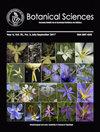Vascular plants of the Médanos de Samalayuca natural protected area, Chihuahua, Mexico
IF 0.7
4区 生物学
Q3 PLANT SCIENCES
引用次数: 0
Abstract
Background: Inland sand dunes are expanding and increasing mobility. Knowledge on the plants growing on them is keystone for their management. One of the largest inland dune systems in Mexico is the Médanos de Samalayuca area. Questions: How many and which species of vascular plants are in Samalayuca? Which is the distribution pattern of that flora? Are there endemisms? Are there species of conservation concern? Studied species: Vascular plants. Study site and dates: Médanos de Samalayuca protected area, northern Chihuahua, Mexico; 2017-2022. Methods: A database was generated based on literature, electronic sources, herbarium specimens, photographing, and collection and identification of materials. Distribution, endemism level and conservation status were recorded. Results: The updated checklist of vascular plants for Samalayuca includes 400 species of 246 genera and 65 families. Most species grow in Mixed desert scrub and in Sand dune vegetation. Almost a half are restricted to the Megamexico 1 region, followed by the North American element. One species is Threatened according to the Mexican Official Norm NOM-059, while two are Vulnerable and one is Almost threatened according to the IUCN. Ribes fontinale appears to be extinct. Conclusions: Considering the arid, extreme climate and the low stability of the psammophilous vegetation, the flora of Samalayuca is richer than expected. The area is home to regional and local endemics. The data and information generated here is baseline for further management programs and action planning to protect these fragile ecosystems and the adjacent communities.墨西哥奇瓦瓦州 Médanos de Samalayuca 自然保护区的维管束植物
背景:内陆沙丘不断扩大,流动性不断增强。对生长在上面的植物的了解是管理它们的基石。墨西哥最大的内陆沙丘系统之一是msamalayuca地区。Samalayuca有多少种维管植物?该植物群的分布模式是什么?有地方病吗?有需要保护的物种吗?研究种类:维管植物。研究地点和日期:墨西哥奇瓦瓦州北部Samalayuca保护区;2017 - 2022。方法:以文献资料、电子资料、植物标本馆标本、摄影资料和资料收集鉴定为基础,建立数据库。记录了分布、特有程度和保护状况。结果:更新后的维管植物名录包括65科246属400种。大多数种生长在混合沙漠灌丛和沙丘植被中。几乎有一半局限于Megamexico 1地区,其次是北美元素。根据墨西哥官方标准NOM-059,一个物种受到威胁,两个物种脆弱,一个物种根据世界自然保护联盟几乎受到威胁。fontinale部落似乎已经灭绝。结论:考虑到干旱、极端气候和沙土植被稳定性较低,沙马拉尤卡的植物区系比预期的要丰富。该地区是区域性和地方性流行病的发源地。这里产生的数据和信息是进一步管理计划和行动计划的基础,以保护这些脆弱的生态系统和邻近的社区。
本文章由计算机程序翻译,如有差异,请以英文原文为准。
求助全文
约1分钟内获得全文
求助全文
来源期刊

Botanical Sciences
Agricultural and Biological Sciences-Plant Science
CiteScore
1.90
自引率
21.40%
发文量
71
审稿时长
16 weeks
期刊介绍:
Botanical Sciences welcomes contributions that present original, previously unpublished results in Botany, including disciplines such as ecology and evolution, structure and function, systematics and taxonomy, in addition to other areas related to the study of plants. Research reviews are also accepted if they summarize recent advances in a subject, discipline, area, or developmental trend of botany; these should include an analytical, critical, and interpretative approach to a specific topic. Acceptance for reviews will be evaluated first by the Review Editor. Opinion Notes and Book Reviews are also published as long as a relevant contribution in the study of Botany is explained and supported.
 求助内容:
求助内容: 应助结果提醒方式:
应助结果提醒方式:


